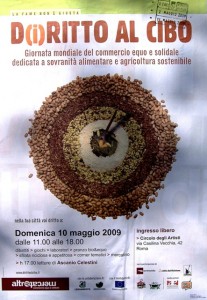English Russia is an “entertaiment blog devoted to the events happening in Russian speaking countries.” Quite often fun but not, you would have thought, likely to feature much of agrobiodiversity interest. And you’d be right. For 99% of the time at any rate. Because there was a post a few days ago with truly amazing colour photographs of the Russian Empire from a hundred years ago, and many show farming products and activities. They’re by Sergei Mikhailovich Prokudin-Gorskii, according to one of the comments, and he had a Library of Congress exhibition devoted to him in 2003, whose website is where it seems most of the images in the English Russia post originated. Well worth exploring. I wonder if some of these images could be used to compare with the present. For example, are these melons still to be found in Samarkand?
Happy World Fair Trade Day!
Today, May 9th is World Fair Trade Day, apparently. I had no idea until I saw this poster a few days ago. And even then there was some confusion as for some reason the date on it is the 10th.

The theme is food sovereignty and sustainable agriculture. There’s a great-looking programme being organized here in Rome. Anyway, as an old germplasm collector, I can really relate to all those seeds on the poster.
Wild pig doing just fine
Professor John Fa, director of conservation science at the Durrell Wildlife Conservation Trust, one of the partners in the Pygmy Hog Conservation Programme (PHCP), described the pigs as “enigmatic.”
Maybe they just don’t want to get swine flu. I mean, look what happened to Khanzir.
Fungus flavours fermented food
Did you know that…
[t]he edible fungus Monascus purpureus imparts a distinct flavor and red color when added to fermented rice dishes such as those served in Asia.
Neither did I. But the boffins at USDA do.
Happy 25th, LEISA!
LEISA Magazine has chosen a fitting theme to celebrate its jubilee: diversity.
It expresses itself in many ways. There are diverse landscapes and ecosystems, diverse ways of life, diverse crops and agricultural systems. Small farms have been naturally benefiting from the diversity in their natural environment.
I wont even try to summarize. The contents are here. To the next 25 years!